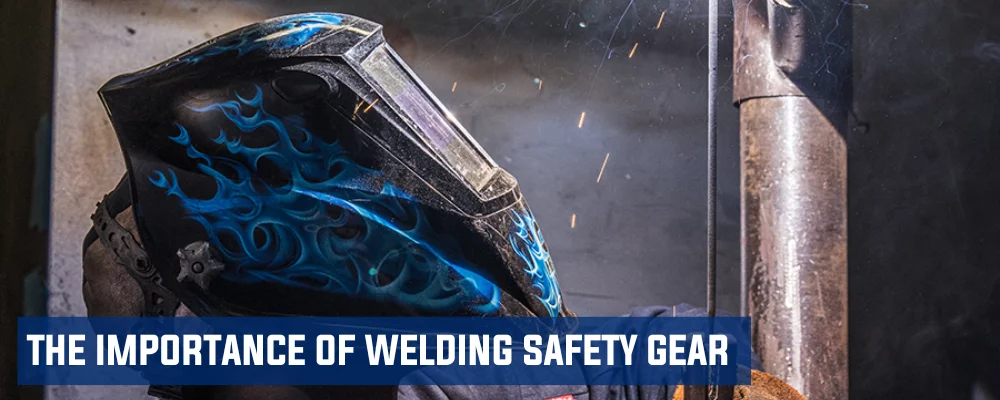Personal protective equipment (PPE) is important for welders because there are hazards when welding, cutting, and brazing. These hazards can include exposure to metal fumes and UV radiation, burns, shocks, cuts, and broken toes.
According to the Occupational Safety and Health Administration (OSHA) and the American Welding Society (AWS), the best way for welders to stay safe on the job is to wear head-to-toe protection and use welding safety equipment. Although not all of the following safety measures are required, it’s important for welders to have the right welding protective gear to help prevent work-related injuries.
If the right safety measures are taken, welding can be a satisfying career choice. Delta Technical College offers two programs in welding: Welding Program and Welding & Pipefitting Program. All welding programs at Delta Tech include safety training.
Welding Safety Supplies to Prevent Eye Injuries
- Welding Helmets
A welding helmet is one of the most important pieces of welding safety gear welders use. According to the OSHA fact sheet on eye protection, the radiant energy or light radiation from arcs or flames can cause injuries to welders’ eyes. A lens shade number indicates the amount of light radiation that can pass through the filter on a welder’s helmet. Choosing helmets with the proper lens shade number is essential to preventing eye damage and should stop exposure to harmful radiation. A proper welding helmet can also protect against sparks reaching a welder’s face or eyes.
Auto-darkening filters (ADFs) on helmets are also suggested by the AWS. ADFs may reduce repetitive stress injuries caused by raising and lowering the filter, and the fixed setting reduces many risks associated with exposure from lifting the filter. A simple welding cap or beanie, which can be worn under a helmet, is often included on welding safety equipment or personal protective equipment (PPE) lists.
- Safety Glasses
The most common welding injuries are eye injuries caused by particles, irritation, or UV radiation exposure, and they account for nearly one-quarter of all welding injuries. Wearing safety goggles is an OSHA requirement and the type of protection used must comply with ANSI Standard Z87.1 , Practice for Occupational and Educational Eye and Face Protection.
Welding Safety Supplies for Full-Body Protection
- Welding Jackets
A welding jacket is standard for any welding safety gear list or PPE list. While leather is often recommended because it isn’t flammable and provides protection, many welders find leather too hot and prefer fire-resistant cotton jackets with leather sleeves. Some welders also choose to wear leather aprons under their jackets for an extra layer of protection.
- Gloves
A welder should never work without gloves. According to OSHA, it is essential that welders use the correct gloves specific to the jobs they are performing. Welding gloves may be made of leather, canvas, or metal mesh and cover a welder’s hands and lower arms.
- Boots
A good pair of boots or foundry shoes is important for every welder and should comply with Active Standard ASTM F 2413, Standard Specification for Performance Requirements for Protective (Safety) Toe Cap Footwear. The standard boot style on most PPE lists and for many welders are leather work boots with rubber soles and steel toes. Some welders choose boots without laces to prevent the risk of sparks burning the laces. Metatarsal covers can be placed over laced boots to lower the risk of sparks igniting, and to provide extra safety from foot injuries that can happen on the job.
Interested in Learning More About DTC?
Fill out the form below to receive info about our career training programs.
Welding Safety Equipment for The Work Environment
- Fire Extinguishers
There are some fire risks associated with welding. Arc welding in particular can pose a high fire risk, so all welding shops should have fire extinguishers according to OSHA regulations. It’s also important to remove all hazardous or flammable materials from all welding shops and job sites.
- Grounding Equipment
The choice of grounding tools may vary depending on the type of welding equipment used and the risks associated with welding jobs. To avoid the risk of electric shock, it’s important to ground all welding equipment that isn’t double insulated.
- Welding Respirators
There are a variety of different welding respirators, and should be chosen based on the welders’ needs. The AWS recommends them for welders because of the risk of asthma and pneumonia from exposure to fumes. Welding respirators can be worn under helmets and should fit comfortably.
Begin Your Path to Becoming A Welder
If you’re interested in becoming a welder, please contact the Admissions Team at Delta Tech for more information about their welding programs.
Sources:
[1] https://www.osha.gov/
[2] https://www.aws.org/
[3] https://www.osha.gov/Publications/OSHAfactsheet-eyeprotection-during-welding.pdf
[4] https://www.aws.org/library/doclib/fs31-201404.pdf
[5] https://www.osha.gov/Publications/OSHAfactsheet-eyeprotection-during-welding.pdf
[6] https://www.osha.gov/Publications/osha3151.pdf
[7] https://www.astm.org/Standards/F2413.htm
[8] https://www.osha.gov/pls/oshaweb/owadisp.show_document?p_id=9853&p_table=STANDARDS
[9] https://www.thefabricator.com/article/arcwelding/staying-grounded
[10] https://www.aws.org/resources/detail/dealing-with-welding-fumes
[11] https://www.bls.gov/ooh/production/welders-cutters-solderers-and-brazers.htm#tab-1



